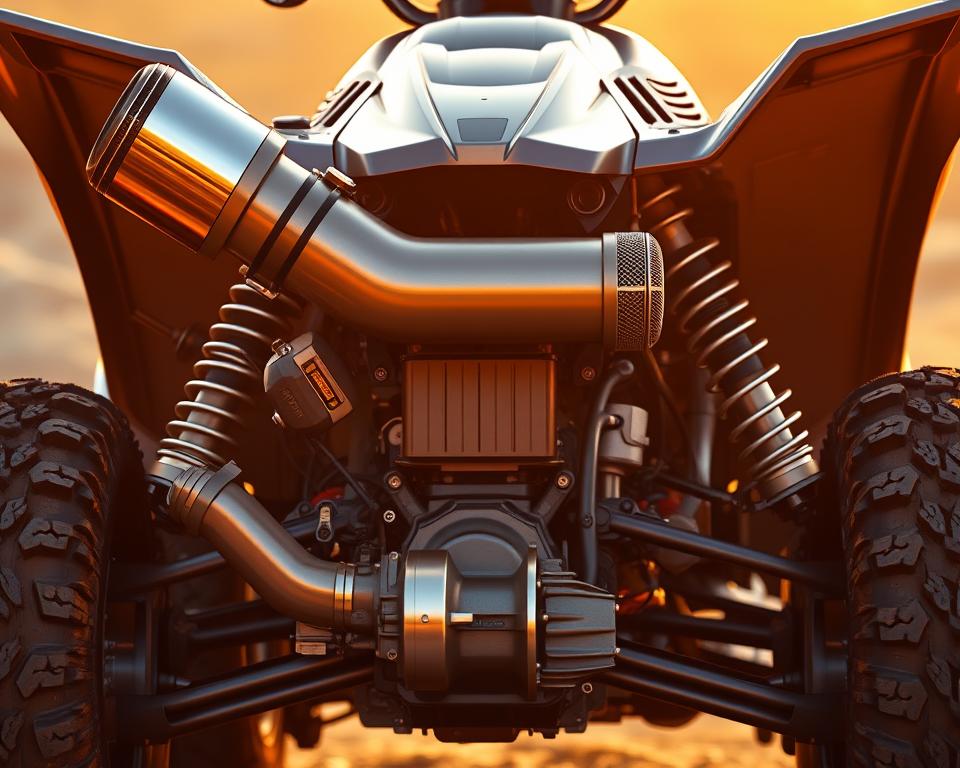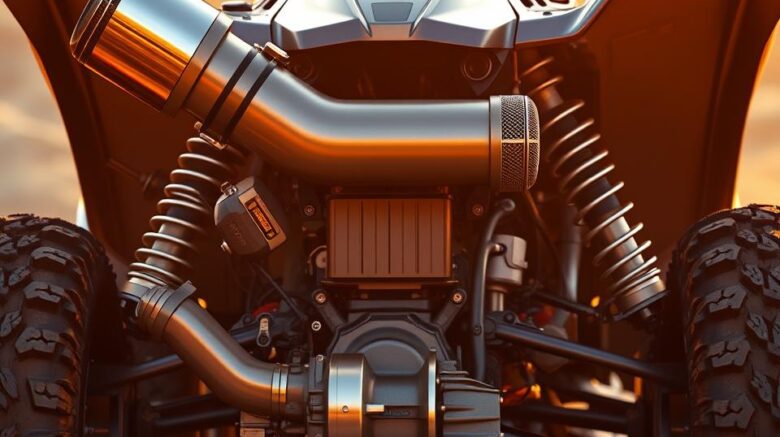Essential ATV Off-Road Checklist for Safe Riding
Have you heard nearly 450,000 ATV-related injuries are treated in U.S. emergency rooms each year? This alarming figure highlights the need for safety and preparedness in off-road adventures. Here’s your go-to ATV Off-Road Checklist for maximum safety and enjoyment. Whether you’re tackling rocks or dunes, it’s all included. Armed with proper safety equipment and Can Am renegade lift must-haves, you’ll reduce hazards and amplify the fun.
Key Takeaways
- Prioritize safety by using the Essential ATV Off-Road Checklist for optimal preparation.
- Don’t hit the trail without this ATV safety gear list.
- Maintenance matters: check often, ride better.
- Hydration and nutrition boost endurance and focus on long rides.
- Don’t wander: rely on trusty navigation tools.
- Pack layers and waterproofs for all conditions.
- Your tool and recovery kit can save the day on the trail.
Understanding the Importance of Safety Gear
Off-road adventures require a strong focus on safety. ATVs deliver thrills—and risks. Safety gear is essential for protecting riders from accidents and injuries. Being well-equipped ensures a safer ride and follows an ATV safety gear checklist.

Essential Protective Gear
Maximizing protection involves several key items:
- Helmets: Always use a DOT helmet to guard against head trauma.
- Goggles: Protect your vision with wraparound goggles.
- Gloves: Wear durable gloves for better grip and hand protection.
- Boots: Wear sturdy boots that cover the ankles to prevent injuries.
- Body Armor: Chest and back armor add vital protection.
- Neck Protection: Neck braces can help reduce the risk of spinal injuries.
Emergency Preparedness
Don’t overlook your emergency kit. An effective emergency kit can be a lifesaver in unexpected situations. Key items to include are:
- First aid kit
- Multi-tool
- Tire repair kits
- Portable air compressors
- Emergency blankets
- Whistles
- Matches
ATV Equipment for Optimal Performance
Gear choices affect how well your ATV runs. Pack these essentials for any trail. Regularly following an ATV maintenance checklist helps maintain your machine’s functionality and longevity.
Must-Have ATV Equipment
- Durable Tires: Terrain-specific tires keep you glued to the track.
- Cargo Systems: Keep tools and spares within reach.
- Fuel Reservoir: Opt for a robust tank to avoid drips and dry runs.
- First Aid Kit: Stock your kit with bandages, antiseptic, and meds.
Regular Maintenance for Longevity
Routine care keeps breakdowns at bay. Regular inspections should encompass:
- Checking air filters to keep the engine running smoothly.
- A well-lubed chain spins quietly and reliably.
- Inspecting brakes for safety before each ride.
This ATV maintenance checklist is essential for keeping your vehicle in peak condition and ready for adventure.
The Essential ATV Off-Road Checklist
Don’t skip your pre-ride safety scan. An effective ATV maintenance checklist ensures your vehicle’s safety and performance. Each pre-ride inspection step requires attention to detail. A thorough pre-ride assessment is key to a safe outing.
Pre-Ride Inspection Basics
Before any off-road journey, a pre-ride inspection is vital. Catch faults early with a fast inspection. Key elements to check include:
- Tire pressure and tread condition
- Fluid levels such as oil and fuel
- Brakes and controls functionality
- Operational lights and horn
- Chain or driveshaft integrity
T-CLOC Inspection Method
T-CLOC covers every critical system. It covers Tires and Wheels, Controls, Lights, Oil and Fuel, and Chain/Driveshaft. This method ensures all critical areas are covered:
| Inspection Area | Checklist Items |
|---|---|
| Tires and Wheels | Check tire pressure, inspect tread depth, look for damage |
| Controls | Test brakes, throttle, and clutch for smooth operation |
| Lights | Ensure headlights, brake lights, and indicators are functioning |
| Oil and Fuel | Check oil level, inspect for leaks, and fill fuel tank |
| Chain/Driveshaft | Examine for wear, proper tension, and lubrication |
A quick T-CLOC saves you big trouble later. By checking these essential components, riders can avoid breakdowns.
Hydration and Nutrition for Long Rides
Don’t underestimate water and snacks on extended outings. Riders often underestimate their fluid needs, making it essential to plan ahead. Water packs help maintain endurance and alertness. Nutritious snacks power you through rough stretches.
Importance of Staying Hydrated
Dehydration leads to poor decisions and slow reflexes. A hydration pack with sip tube makes it easy. Consider using a hydration pack for convenience and to monitor water intake effectively.
High-Energy Snacks to Pack
Choosing the right snacks is vital for extended ATV rides. Pack portable, long-shelf treats. Some ideal choices include:
- Protein bars
- Nut mixes
- Dried fruits
- Beef jerky
These snacks provide a quick energy boost without hindering the riding experience. Mix sweet and salty options for flavor and function.
Navigation Tools for Off-Roading Adventures
Stay on course with proven navigation aids. Off-road navigation tools are invaluable for staying on track, no matter the terrain.
Advanced GPS Systems
An advanced GPS system is a must for off-road adventures. Look for features like offline maps and a long-lasting battery. Brands like Garmin and TomTom offer models designed for off-road use, ensuring durability and precision.
Traditional Navigation Aids
Always carry a paper map along with your GPS. A compass never needs a signal. Wind your own way with map and compass skills. Combining advanced tech with traditional aids prepares you for any situation on your journey.
Communication Equipment for Safety
When phones fail, two-way radios deliver. Clear comms keep your group coordinated. Talking to your team prevents misadventures.
For seamless communication among group members, a quality two-way radio is highly recommended. These devices ensure clear audio over long distances. Get instant alerts about obstacles ahead. When choosing two-way radios, look for models with:
- Weatherproof construction to resist the elements
- Extended run-time for extended trips without needing a recharge
- Multiple channels for clear communication without interference
No ride is complete without radios. They keep everyone coordinated and secure. They provide a vital communication line in tough environments. Stay connected, stay safe.
Self-Rescue Gear for ATV Riders
Don’t be caught unprepared—pack rescue gear. Relying on yourself starts with proper rescue tools. Prepared riders make safer group members.
Winches and Recovery Kits
A winch can drag you out of any rut. Kit up your winch for maximum extraction muscle. Recovery kits usually include:
- Tow straps
- D-rings
- Recovery boards
- Gloves
Practice recovery techniques before you need them. With quality ATV recovery kits, you can overcome mud, rocks, or other obstacles and continue your journey.
Trail Recovery Essentials
Pack these extras along with your winch. These include:
| Equipment | Purpose |
|---|---|
| Recovery Straps | Used for towing or pulling ATVs out of tight situations. |
| Shovel | Helps clear obstacles and dig out vehicles when stuck. |
| Traction Mats | Provides grip under tires in muddy or slick conditions. |
| Portable Air Compressor | Enables quick tire inflation after deflating for better traction. |
Don’t rely on luck—bring the right tools. Knowing how to use these tools greatly improves safety and adventure on your off-road excursions.
Staying Adaptable: Preparing for Weather Changes
Trail weather can change in minutes. Be prepared for sun, rain, or wind at any moment. Don’t forget your layers and rain shell.
Layering your clothes is key to adapting to temperature changes. Begin with a moisture-wicking base layer to manage sweat. Mid-layers trap heat and pack small. Lastly, have a waterproof and wind-resistant outer shell. This setup ensures you stay comfortable, no matter the weather.
Weather-Appropriate Clothing
- Rain Shells: A must-have for sudden downpours.
- Breathable Pants: Allows for ventilation while protecting against wet conditions.
- Sun Protection: Shield skin from sunburn with proper apparel.
- Insulated Gloves: Warm gloves maintain dexterity in chill.
Quality weather gear is a must for a great off-roading experience. Stay focused on the trail, not on being wet or cold.
Tools for On-Trail Repairs
Having the right tools for on-trail repairs is key to a safe and enjoyable off-roading experience. Don’t skimp on repair gear. These tools help address minor breakdowns or issues that may arise during your adventure.
Must-Have Tools and Kits
No ride is complete without a toolkit. This kit should include essential items for quick repairs. Critical ATV repair tools might include:
- Tire irons for changing flat tires
- Pliers for gripping and cutting
- Wrenches for various sizes of bolts and nuts
- A multi-tool for versatility
- Spare items such as spark plugs and electrical wire
- Duct tape for quick fixes
Tools at hand mean no surprises.
Basic Emergency Supplies
Tools alone won’t save you—bring these extras. These supplies help ensure your safety in challenging situations:
- First aid kit for injuries
- Flashlight with extra batteries for night-time visibility
- Emergency whistle for signaling assistance
- Reflective triangles or flares to warn other riders
- Water and high-energy snacks for sustenance
Preparation pays off big time. Never leave home without them.
The Bottom Line
Well-planned rides are the best rides. Check off each item and pick reputable brands. Be set for rocks, sand, mud—anything.
With the right protective gear, navigation tools, and communication equipment, you’re set for safe riding. Plan smart to ride hard and safe. Focus on fun, not fears.
Gear up, stay sharp, and savor every off-road second. Every leg of the trip matters. Check this list, then conquer nature.
FAQ
What belongs on an ATV gear list?
Start with a DOT helmet and sturdy goggles. Gloves, suitable footwear, and body armor are also necessary. Neck braces offer additional protection. Also bring a medical kit and adaptable multi-tool.
How do I keep my ATV in top shape?
Inspect air filters and grease the chain often. Inspect brakes as well. A consistent maintenance routine extends your machine’s life and keeps it ready for off-road adventures.
What does the T-CLOC inspection method entail?
T-CLOC inspects five critical systems. It includes checking Tires and Wheels, Controls, Lights, Oil and Fuel, and Chain/Driveshaft. Using T-CLOC guarantees safe, smooth rides.
How much water should I bring on an ATV trip?
Pack extra hydration for safety. Accurately estimating hydration needs prevents fatigue, which is critical during long rides. Hydration packs make accessing water easy.
How to stay on course off-road?
Get a durable GPS with offline maps. Backup with maps and a compass ensures you never get lost.
Why is communication important when off-roading?
Comms keep groups connected and safe. Radios work where phones don’t.
Must-have self-rescue tools?
Every ATV rider should carry a winch and a detailed recovery kit. This kit should include tow straps, D-rings, and recovery boards.
How can I prepare for sudden weather changes while off-roading?
Use a base, mid, and shell layering system. Waterproof gear is necessary to stay dry during unexpected rain. Wear sun-blocking fabrics and hats.
Which trailside tools matter most?
For on-trail repairs, pack a basic tool kit for minor fixes. Have spares and tape for quick fixes.
